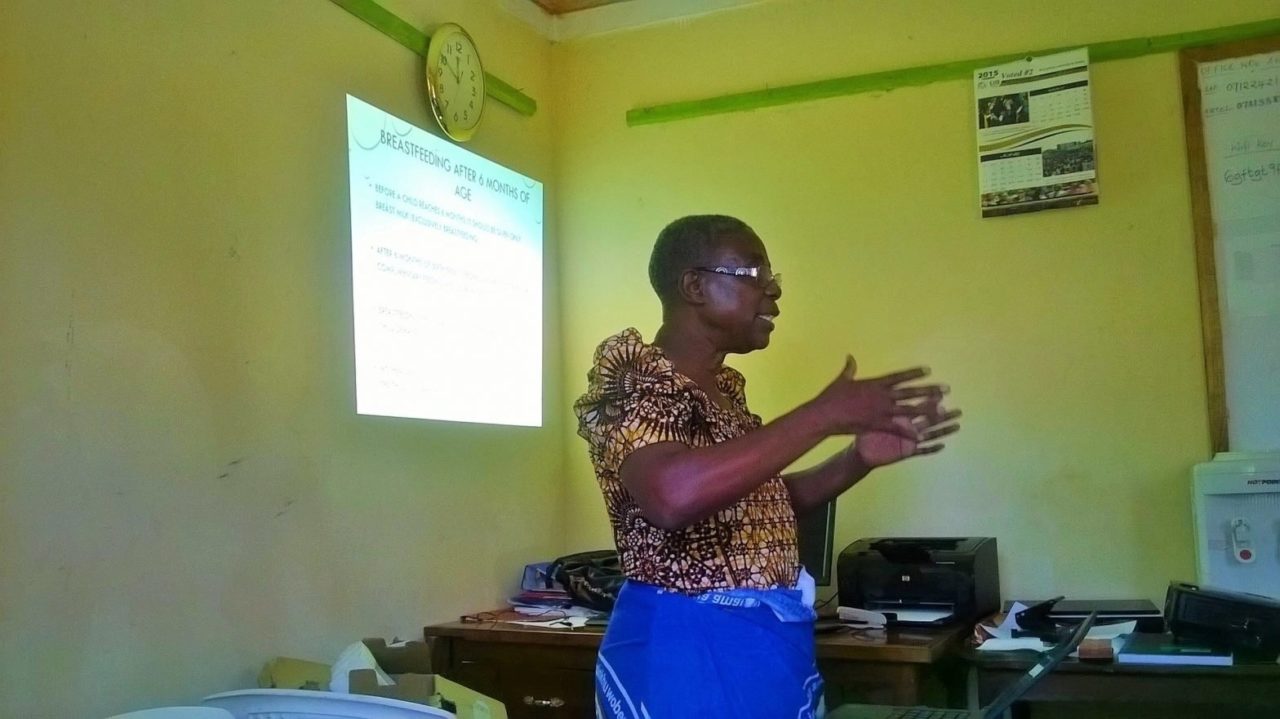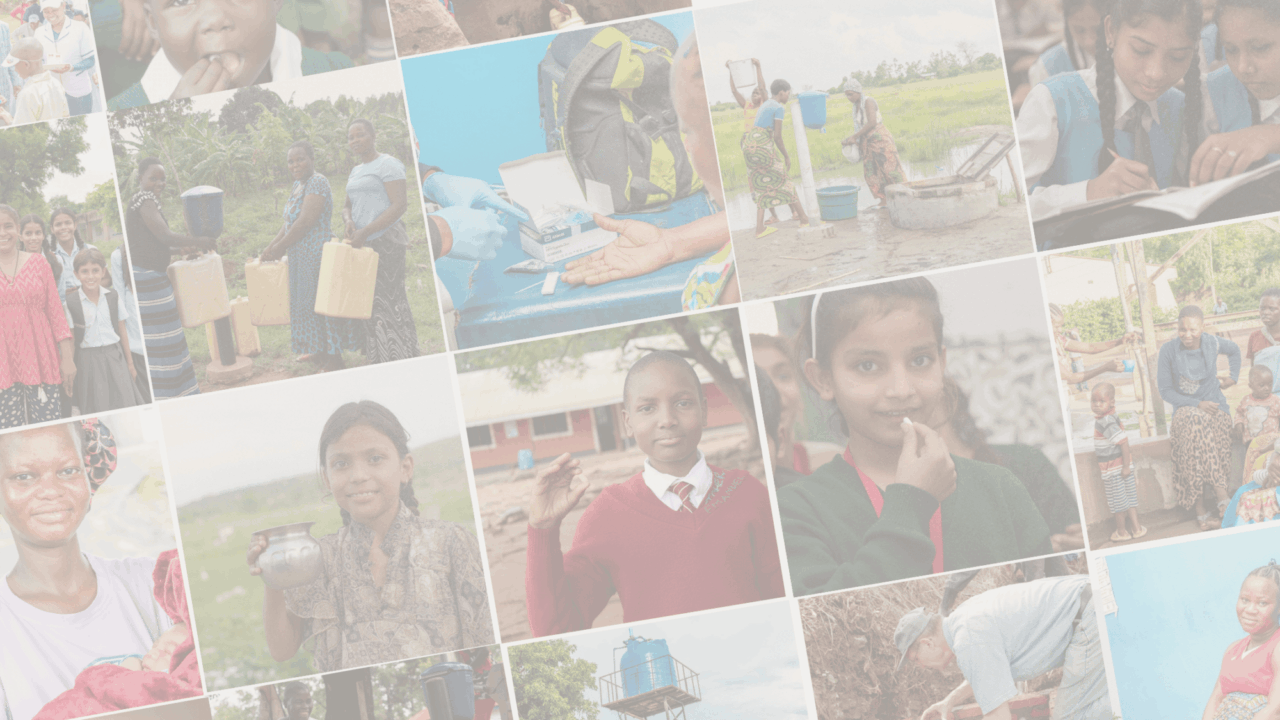At Evidence Action, we are keen to explore ways to increase our impact by leveraging existing programs to deliver other cost-effective solutions to millions. One of our flagship programs, Dispensers for Safe Water, currently serves more than 4.9 million people in Kenya, Malawi, and Uganda. A key part of this rural water service is a chlorine dispensers installed at the local water source. Maintenance and education on using the dispenser is provided by local promoters, individuals that were elected by their community.
In 2015, we began exploring the potential of leveraging the Dispensers for Safe Water network of local water promoters to deliver nutritional messages to families. We believe that the existing network of trained and dedicated individuals can provide a cost-effective way to increase household knowledge about nutrition, and potentially reduce undernutrition and malnutrition among children.
Motivated by the success of a similar intervention in Malawi, we are testing a nutritional messaging program at 230 dispenser locations in Kenya. We are currently assessing the impact of the program on the nutritional status and growth of young children.
How it all started
Unsafe drinking water is one of the main causes of diarrhea and undernutrition. According to the World Health Organization, diarrhea is a leading cause of malnutrition in children under five years of age. Every year, it is the cause of death for over 760,000 children under five years of age. This evidence suggests that provision of safe drinking water is essential for improving children’s health and nutrition.
We partnered with the NGO PATH and its Nutrition Embedded Evaluation Program (NEEP) to understand the nexus between safe drinking water and nutrition, and to test the program in Kenya. PATH and the UK Department for International Development (DfID) are funding programs with the intention of finding evidence for what works in improving maternal and child nutritional outcomes. We hope to better understand whether we can leverage the highly effective and highly regarded promoters that we recruit and train for Dispensers for Safe Water for additional health services. This would use their expertise and credibility in new ways – if it works.
MaiMwana – Delivered by Community Promoters?
Our program in Kenya is modeled after an infant feeding intervention in Malawi implemented by MaiMwana project in the Central region of Malawi, a community mobilization intervention to improve mother and child health and reduce mortality.
A randomized control trial of the MaiMwana program found that the intervention resulted in less infant mortality and improved height-for-age among young children. Nutrition information on infant feeding is simple and non-technical and presented to the mothers of babies aged less than six months by other local women.
Dispensers for Safe Water uses its local promoters to provide maintenance and education on the use of dispensers to the community. In the NEEP program, promoters now also deliver nutritional messages. Messages include, for example, informing mothers that after six months breast milk is not enough for the baby with suggestions for food to supplement. The promoter has a picture book to show examples of appropriate and locally available infant food.
We have partnered with the MaiMwana team and its principal investigator Marco Vera-Hernández from the Institute for Fiscal Study (IFS) in London to evaluate the impact of the program in Kenya.
The Evaluation
With support from PATH, we are evaluating the impact of delivering nutritional messages to household on children’s health and nutritional status. Evidence Action’s Beta team is working with our in-house Monitoring, Learning, and Information Systems department to collect and analyze the relevant data.
The evaluation started with adapting the teaching materials from Malawi to the Kenyan context. In September 2015, we trained Dispensers for Safe Water promoters to deliver nutritional messages to households with children aged 6-24 months. This includes home visits by our trained promoters, targeted messaging on child nutrition, and informational posters on the physical development indicators for children. Promoters do not get paid; they provide these messages on a voluntary basis.
The 18-month clustered randomized control trial looks at the marginal impact of the nutritional messaging campaign on parental knowledge about nutrition, and households’ decisions related to nutrition and consumption. In addition the trial looks at height-for-age to determine the impact of the nutritional messages. We do not, however, focus on infant mortality as this may not always be a direct result of undernutrition or malnutrition.
The trial consists of three arms:
- a control arm in which the trained promoter visits the household to provide WASH information;
- a WASH + nutrition treatment arm for mothers in which the trained promoter provides WASH information to the household, but also provides nutrition information to the child’s mother; and
- a WASH + nutrition treatment arm for both mother and father in which the trained promoter provides the same information as in the traditional NEEP arm but encourages the father to join the visit. The thinking here is that it is often the father who decides what is being bought for the household and thus has considerable influence on the nutritional status of the family.
Promoters and Health Education = A Winning Combination for Child Health?
The results of the RCT, to be concluded in 2017, will also inform us about whether our program promoters can effectively deliver multiple messages to communities. If delivering nutritional messages through are promoters is proven to be successful, we can potentially use promoters to achieve greater impact on child health. The results will also be important to policy makers and donors attempting to improve nutritional outcomes at a low cost using community resources.



